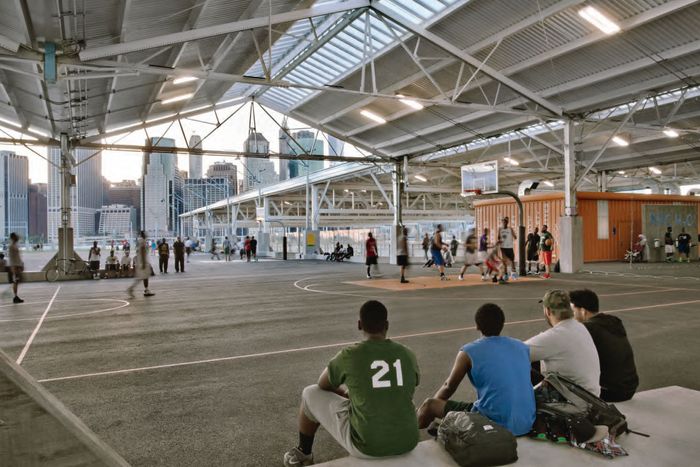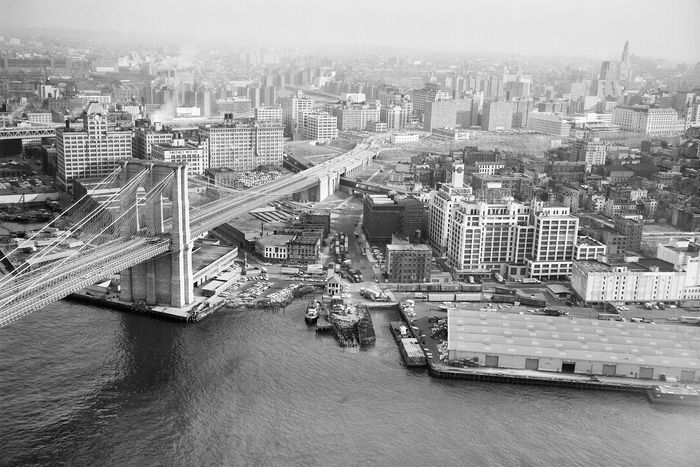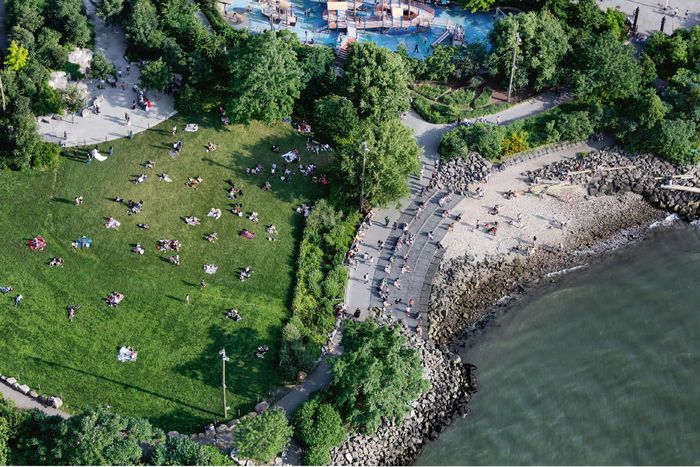What Did Brooklyn Bridge Park Get So Right?

Photo-Illustration: Elizabeth Felicella/Etienne Frossard/Monacelli images
Improbably, Brooklyn Bridge Park exists. That’s not an outcome I would have bet on a couple of decades ago when the waterfront below Brooklyn Heights was a DMZ of flat, hard wharves that spoiled otherwise glittering views of New York Harbor. Even more miraculous, the park is an 85-acre civic masterpiece. Ambling through curtains of thick, dark vegetation that open suddenly onto the high drama of the Manhattan skyline, I find it hard to remember a time when the only greenery here consisted of tenacious weeds. The park spent a decade as a sketch of itself, even as its various piers and parts revealed themselves in a tantalizing, frustrating sequence of openings. Finally, a long stretch of nothing happening, of innumerable plans, tradeoffs, controversies, objections, and delays — that whole impasto of New York–style dithering — has been overwhelmed by the vivid, sensual presence of one of the city’s great public spaces. On a hot June afternoon, I watched children roll down a grassy incline and marveled at the huge effort of imagination that was needed to look at all that abandoned concrete and in its place conjure hills, dales, bowers, meadows, and wetlands. Credit for summoning them all into being goes largely to MVVA, a team of landscape architects led by Michael Van Valkenburgh, which has just published a justifiably self-congratulatory book about the process of getting so many decisions right and so few wrong.
Van Valkenburgh takes a proprietary interest in the project, prowling it often with park staff and keeping an active to-do list, long after he cashed the final check for his services. This obsessiveness is shared by the Brooklyn Bridge Park Corporation’s staff and is made visible in the lack of litter, the unsplintered benches, the working toilets, and the thick profusion of plants. Attention to detail is not the same thing as a need for order, and the passing years have given the plantings a pleasingly anarchic quality: the privet hedges spreading wildly near the Atlantic Avenue entrance to form a cool, shady portico on either side of the avenuelike path; a meadow teeming with wildflowers; secret hideouts enfolded in shade, scattered stands of oak, and bursts of sumac. The designers rejected an array of more buttoned-up precedents to define Brooklyn Bridge Park partly by all the parks it’s not: a set of French-style allées, a show garden of bravura horticulture, a mosaic of different activity zones, or a picturesque emulation of wilderness. Instead, MVVA mashed some of those models together into a new kind of urban edge: spectacular but un-precious, informal but highly artificial, tough enough to withstand crowds and violent weather. That sort of multilayered buffer zone between city and sea has evolved into a new standard for the era of aggressive weather, so that storm-pushed tides, instead of hurling themselves destructively against armored bulwarks, can rush in, stay awhile, collect in an underground cistern, and ebb slowly back out.
Photo: Elizabeth Felicella/Monacelli
The park’s uniqueness makes it hard to emulate; its success makes it hard not to. The same is true of the High Line, which has spawned a thousand knockoffs, but the essence of Brooklyn Bridge Park is more complex than a long green catwalk above the street. The design was taking shape just as the transformative power of urban landscape was slowly becoming clear: A city park would no longer be merely a place of respite and play for birds and overstressed humans; it was now also being asked to correct the past’s mistakes, clean up industrial filth, and soften the blows of climate change. This one is the major node in an incomplete citywide membrane enfolding all those serried buildings. You can now walk (or bike) along the water’s edge from Atlantic Avenue to the Brooklyn Bridge, across the East River, around the tip of Manhattan to Battery Park, and all the way up the Hudson to the George Washington Bridge. A more broken-up route that is gradually filling in takes you up the east side of Manhattan or the west edge of Brooklyn to the Bronx. Which is to say Brooklyn Bridge Park constitutes a form of metropolitan therapy rescuing the city’s relationship with its waterways. Its anthology of New York’s 520 miles of varied shoreline — sandy beach, spongy wetland, wave-diffusing riprap, elevated piers — can mitigate floods and, equally important, survive them. When Superstorm Sandy hit in 2012, the still tender plantings took on inconceivable quantities of saltwater and most made it through healthy and intact. For planners around the world, Brooklyn Bridge Park is irrefutable proof not only that a city can adapt to climate change by reengineering its edge but that the process can — should — yield beauty, joy, and romance.
The industrial scene before the park (seen here in 1961).
Photo: Courtesy NYC Municipal Archives
Not solitude, though, or rarely. Roughly a third of users come from the surrounding neighborhoods, a third from farther-flung neighborhoods, and the rest from out of town, paying a total of 5 million visits each summer. On weekends, it can feel as if they’re all there at once. The kids’ water playground at Pier 6 is so popular that caregivers play musical chairs for the few seating spots and losers stand along the shaded fence. In 2016, the Times reported that rowdy, mostly Black teenagers headed for the basketball courts on Pier 2 were agitating residents of Brooklyn Heights. To me, those crowds, complaints, and conflicts are evidence that the park has knitted itself to the rest of the borough and the city as a whole, sharing its jostle as well as its pleasures. It was never intended as a bucolic retreat.
The location provides vastness: broad river, craning towers, open sky draped between boroughs, and a panorama of the whole history of New York, from the first Dutch settlement on Governors Island to skyscrapers still under construction. Within that immensity, Van Valkenburgh’s team fashioned pockets of intimacy and a variety of microhabitats. A greenway wiggles its way north-south like a woozy avenue, and side paths wander off toward beach, rocky coast, and marsh or into manmade uplands. Pier 3 is a countryside on a pier, its central oval bordered by woods. Circumambulate it and you come across a cluster of toddler-size mooring bollards lurking in the shrubbery like a party of short, horned aliens. Some forms of fun are separated into specialized zones, and others intertwine, their rich, hocketing counterpoint a mixture of the planned and the uncontrollable.
Even when the site resembled a postindustrial blank slate, it brimmed with complexities and constraints. It was depressingly flat. Some of the piers were sturdy, one was crumbling. Disused sheds still stood, barely. The footprint was ample but awkwardly long and narrow. The only access points below the Brooklyn Bridge lay at either end, from Atlantic Avenue to the south and Fulton Street to the north, with a narrow Joralemon Street passage in between. Floods, saltwater spray, and winter winds laid siege to vulnerable plants. The most formidable obstacle to a peaceable refuge was the double-decker section of the Brooklyn-Queens Expressway that hugs the cliff below Brooklyn Heights. Trucks thundering overhead made it seem absurd to think anyone would ever relax within earshot. One strategy was what Van Valkenburgh calls an “unflattening” of the site: using rock, rubble, and soil to build up artificial hills as the landscape-architecture firm West 8 did on Governors Island. The astoundingly effective solution to the BQE’s proximity was to erect a set of “sound berms,” steep, high, planted hillsides that deflect the din and fumes and help park users forget they’re playing next to a highway. When I reached the end of the berm on the uplands between Piers 2 and 3 and the road appeared ahead, I suddenly found myself shouting to be heard; a few steps back, and I could practically murmur. The MVVA book details the lengths that landscape architects and engineers went to ensure that berms wouldn’t wash away or collapse, plants would thrive, noise really would be muted, and workers could safely negotiate the slopes. The whole thing was an exercise in virtuoso terraforming.
The landscape absorbs highway noise from above and storm surges from below.
Photo: Alex MacLean/Monacelli
Much of the city’s waterfront lay fallow when Michael Bloomberg became mayor in 2002. Equipped with a sense of urgency and an ambitious to-do list, he cajoled the state into turning the entire site over to the Brooklyn Bridge Park Corporation — that’s what nudged the plan toward reality. Bloomberg did not, however, start by fixing (or persuading the state to fix) the crumbling Brooklyn-Queens Expressway before padding it with artificial hills. This has turned into a colossal problem, the equivalent of tiling a wall before replacing the leaky pipes inside it. In a rational world, the state would have erected a temporary bypass where the sound berms are and rebuilt the expressway, all before work on the park began. The failure to do so left the successive administrations with a menu of terrible options for rescuing the BQE — and a strong incentive to pass the problem on to whoever’s in office when the whole edifice comes tumbling down. It’s easy to drum up shoulda-couldas, but Bloomberg might have correctly calculated that if he had waited to begin construction on the park until the highway issue was resolved, both projects might have died. Better to accomplish at least one.
Photo: Etienne Frossard/Monacelli
The fiercest battles were waged around the decision to tithe a portion of the territory to private developers. Brooklyn activists, who had spent decades beating the drum for a waterfront park, were horrified that the Bloomberg administration would spin it off to a nonprofit corporation and turn over a chunk of acreage to luxury condos. They had a point: The place didn’t even exist yet, and already it was being gentrified. In the end, though, the public got the better deal. Residents of those buildings pay their property taxes directly to the Brooklyn Bridge Park Corporation, and thanks to an absurdly inflated real-estate market, the total annual revenue amounts to double the $15 million operating budget. That leaves the corporation flush enough to cover big-ticket items like repairing the wooden pylons that are constantly being eaten away by marine borers. It can even afford a new entrance pavilion and bathrooms near Pier 1, new artificial turf on the playing fields, and so on. This model leaves planners in other cities enviously amazed since park funding is always a struggle; predictably, it has proved difficult to replicate. But here, at least, it’s clear that the neoliberal mayor was right and progressive opponents were wrong. Sometimes the rich really do pick up the tab for everyone else’s good time.


The pier shed’s structure was retained and reinforced. From left: Photo: Elizabeth Felicella/MonacelliPhoto: Elizabeth Felicella/Monacelli
The pier shed’s structure was retained and reinforced. From top: Photo: Elizabeth Felicella/MonacelliPhoto: Elizabeth Felicella/Monacelli
The result is quintessentially urban with recycled bits of New York all over this new iteration. Visitors sit, perch, and climb on blocks of granite reclaimed from the reconstruction of two bridges. Pier 5 is bordered by the blue-steel skeleton of its long-demolished shed. Benches are made from yellow-pine lumber salvaged from the National Cold Storage warehouse. This frugal reuse links this space of leisure to the heyday of shipping and manufacturing and the shock of its decline. Each chunk of machine-age antiquity exists not just as a picturesque relic but as a reminder of jobs lost, livelihoods shattered, families forced out, pride extinguished, and whole city blocks abandoned. The park is the perfect instance of the reinvention of the city that followed.
Central and Prospect Parks were conceived as vast and soothing preserves deliberately contrasting with the dense agglomeration that their creator, Frederick Law Olmsted, considered noxious. Brooklyn Bridge Park is an enthusiastic participant in city life. It could exist only where it does. “By definition, a park is not nature. The magic of a park is that it enables a personal relationship with nature that is not available in nature,” Van Valkenburgh writes. You can’t truly get away from the city here or completely banish its rumble — not with bridges overhead and helicopters alighting on the opposite shore. But you can gratefully place parentheses around a serene moment before gratefully rejoining the thrum.
Source link








